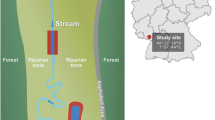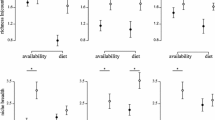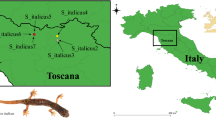Abstract
The seasonal diet and prey selection of the Southern Grey Shrike (Lanius meridionalis) was studied in two different insular habitats: shrub environments of the Canary Islands in coastal and high mountain zones. We measured, in each season, food availability and prey size in order to determine prey size selection of shrikes along an altitudinal gradient. Moreover, we compared the diet patterns observed with those documented on the continent, to determine if Southern Grey Shrikes in the islands’ high mountain zone (which has a continental climate) showed seasonal diet variation similar to those in northern continental areas. We analysed a total of 1,139 shrike pellets collected in 1 year and identified 10,179 prey items. Numerically arthropods (91%), and in terms of biomass lizards (70%) were the main prey consumed by the shrikes. The proportions of the main prey items differed significantly between seasons and habitats. Diet in the coastal areas was less variable than in the high mountain zone. The greater seasonal climatic variation in the high mountain zone was associated with diet patterns similar to those found in some northern continental areas, such as the Iberian Peninsula and southern France. Finally, shrikes selected the largest prey in the high mountain habitat. This suggests that foraging behaviour in this species is related to climatic conditions, as the biggest and most profitable prey were consumed in the most harsh habitats.




Similar content being viewed by others
References
Atkinson EC, Cade TJ (1993) Winter foraging and diet composition of northern shrikes in Idaho. Condor 95:528–535
Ben-David M, Flynn RW, Schell DM (1997) Annual and seasonal changes in diets of martens: evidence from stable isotope analysis. Oecologia 111:280–291
Budden AE, Wright J (2000) Nestling diet, chick growth and breeding success in the southern grey shrike (Lanius meridionalis). In: Yosef R, Lohrer FE, Van Nieuwenhuyse D, Busse P (eds) Proceedings of the 3rd international shrike symposium, vol 22. Ring, Gdansk, pp 165–172
Bustos JJ, Delgado FS (2004) Clima. In: Canseco (ed) Parque Nacional del Teide. Canseco Editores, Madrid, pp 73–96
Castanet J, Báez M (1988) Data on age and longevity in Galloti galloti (Sauria, Lacertidae) assessed by skeletocology. Herpetol J 1:218–222
Castells A, Mayo M (1993) Guía de los mamíferos en libertad de España y Portugal. Ediciones Pirámide, Madrid
Correia AM (2001) Seasonal and interspecific evaluation of predation by mammals and birds on the introduced red swamp crayfish Procambarus clarkii (Crustacea, Cambaridae) in a freshwater marsh (Portugal). J Zool 255:533–541
Craig RB (1978) An analysis of the predatory behaviour of the Loggerhead shrike. Auk 95:221–234
Díaz JA, Carrascal LM (1990) Regional distribution of the Mediterranean lizard: influence of habitat cues and prey abundance. J Biogeogr 18:1–7
Emlen JM (1966) The role of time and energy in food preference. Am Nat 100:611–617
García JT, Arroyo BE (2005) Food-niche differentiation in sympatric Hen Circus cyaneus and Montagu’s Harriers Circus pygargus. Ibis 147:144–154
García Becerra R, Ortega Muñoz G, Pérez Sánchez JM (1992) Insectos de Canarias. Cabildo Insular de Gran Canaria, Las Palmas de Gran Canaria
González P, Pinto F, Nogales M, Jiménez-Asensio JJ, Hernández, Cabrera VM (1996) Phylogenetic relationships of the Canary Islands endemic lizard genus Gallotia (Sauria: Lacertidae), inferred from mitochondrial DNA sequences. Mol Phyl Evol 6:63–71
Gorman ML (1979) Island ecology. Chapman & Hall, London
Grant PR (1965) The adaptive significance of some size trends in island birds. Evolution 19:355–367
Grimm H (2005) Zur Ernährung des Kanaren-Raubwürgers Lanius meridionalis koenigi. Orn Jah Mus Heineanum 23:11–28
Hernández A (1993) Biología de la familia Laniidae (alcaudón real Lanius excubitor L., alcaudón dorsirrojo Lanius collurio L., y alcaudón común Lanius senator L.) en la cuenca del rio Torío, provincia de León. PhD thesis, Universidad de Castilla-León, León
Hernández A, Purroy FJ, Salgado JM (1993) Variación estacional, solapamiento interespecífico y selección en la dieta de tres especies simpátricas de alcaudones (Lanius spp.). Ardeola 40:143–154
Hernández E, Nogales M, Martín A (2000) Discovery of a new lizard in the Canary Islands, with a multivariate analysis of Gallotia (Reptilia: Lacertidae). Herpetologica 56:63–76
Hódar JA (2006) Diet composition and prey choice of the southern grey shrike Lanius meridionalis L. in South-Eastern Spain: the importance of vertebrates in the diet. Ardeola 53:237–249
Hromada M, Kuczyński L, Krištin A, Tryjanowski P (2003) Animals of different phenotype differentially utilise dietary niche-the case of the great grey shrike Lanius excubitor. Ornis Fenn 80:71–78
Karlsson S (2001) Selection of habitat and perches by the great grey shrike Lanius excubitor and the effects of snow layer and prey type. Ornis Svec 11:7–18
Karlsson S (2002) Analyses on prey composition of overwintering great grey shrikes Lanius excubitor in southern Finland. Ornis Fenn 79:181–189
Karlsson S (2004) Season-dependent diet composition and habitat use of red-backed shrikes Lanius collurio in SW Finland. Ornis Fenn 81:97–108
Krebs JR, Stephens DW, Sutherland WJ (1983) Perspectives in optimal foraging. In: Brush AH, Clark GA (eds) Perspectives in ornithology. Cambridge University Press, Cambridge, pp 165–216
Lefranc N, Worfolk T (1997) Shrikes. A guide to the shrikes of the world, Pica Press, Mountfield
Lepley M, Thevenot M, Guillaume C-P, Ponel P, Bayle P (2004) Diet of the nominate southern grey shrike Lanius meridionalis meridionalis in the north of its range (Mediterranean France). Bird Stud 51:156–162
MacArthur RH, Pianka ER (1966) On optimal use of a patchy environment. Am Nat 100:377–385
MacArthur RH, Diamond JM, Karr JR (1972) Density compensation in island faunas. Ecology 53:330–342
Manly BFJ, McDonald LL, Thomas DL (1993) Resource selection by animals. Statistical design and analysis for field studies. Chapman & Hall, London
Martín A, Lorenzo JA (2001) Aves del Archipiélago Canario. Lemus, La Laguna
Marzol Jaén MV (1988) La Lluvia: un Recurso Natural para Canarias. Servicio de Publicaciones de la Caja General de Ahorros de Canarias, Santa Cruz de Tenerife
Moreby SJ (1988) An aid to the identification of arthropod fragments in the faeces of gamebird chicks (Galliformes). Ibis 130:519–526
Nikolov BP, Kodzhabashev ND, Popov VV (2004) Diet composition and spatial patterns of food caching in wintering great grey shrikes (Lanius excubitor) in Bulgaria. Biol Lett 41:119–133
Nogales M (1999) Some ecological implications of the broadening habitat and trophic niche of terrestrial vertebrates in the Canary Islands. Monogr Inst Estud Balear 66:67–82
Nogales M, Hernández MC (1994) Interinsular variations in the spring and summer diet of the Raven Corvus corax in the Canary Islands. Ibis 136:441–447
Nogales M, Valido A (1999) Preliminary data on the structural relationships in two lacertid species of the genus Gallotia (Reptilia: Lacertidae) based on the skeleton. Vieraea 27:217–222
Nogales M, Delgado JD, Medina FM (1998) Shrikes, lizards and Lycium intricatum (Solanaceae) fruits: a case of indirect seed dispersal on an oceanic island (Alegranza, Canaries). J Ecol 86:866–871
Nogales M, Rando JC, Valido A, Martín A (2001) Discovery of a living giant lizard, genus Gallotia (Reptilia: Lacertidae), from La Gomera, Canary Islands. Herpetologica 57:169–179
Nogales M, Quilis V, Medina FM, Mora JL, Trigo LS (2002) Are predatory birds effective secondary seed dispersers? Biol J Linn Soc 75:345–352
Nogales M, Padilla DP, Nieves C, Illera JC, Traveset A (2007) Secondary seed dispersal systems, frugivorous lizards and predatory birds in insular volcanic badlands. J Ecol 95:1394–1403
Olesen JM, Jordano P (2002) Geographic patterns in plant-pollinator mutualistic networks. Ecology 83:2416–2424
Olesen JM, Valido A (2003) Lizards as pollinators and seed dispersers: an island phenomenon. Trends Ecol Evol 18:177–181
Oromí P, Zurita N, Arechavaleta M, Camacho A (2002) Fauna de invertebrados del Parque Nacional del Teide. Ministerio de Medio Ambiente, Parques Nacionales, Madrid
Padilla DP, Nogales M, Pérez AJ (2005) Seasonal diet of an insular endemic population of southern grey shrike Lanius meridionalis koenigi on Tenerife, Canary Islands. Ornis Fenn 82:155–165
Padilla DP, Nogales M, Marrero P (2007) Prey selection of insular lizards by two sympatric predatory bird species. Acta Ornithol 42:167–172
Ralph CP, Nagata SE, Ralph CJ (1985) Analysis of droppings to describe diets of small birds. J Field Ornithol 56:165–174
Rodríguez MA, Santos A, Cantarella F (1994) Estimación del tamaño de la población de Gallotia galloti galloti Oudart, 1839 (Sauria: Lacertidae) en el Malpaís de Güímar (S.E. Tenerife). Studia Oecol 10–11:401–407
Rosenberg KV, Cooper RJ (1990) Approaches to avian diet analysis. Stud Avian Biol 13:80–90
Sangster G, Knox AG, Helbig AJ, Parkin DT (2002) Taxonomic recommendations for European birds. Ibis 144:153–159
Savage RE (1931) The relation between the feeding of the herring off the east coast of England and the plankton of the surrounding waters. Fish Invest Minist Agric Food Fish Ser 2 12:1–88
Schön M (1998) On the evolution of the northern and southern group of subspecies in the great grey shrike superspecies (Lanius excubitor). In: Yosef R, Lohrer FE (eds) Shrikes of the World II: conservation implementation. International Birdwatching Center in Eilat, Eilat, pp 9–13
ter Braak CJF, Šmilauer P (1998) CANOCO Reference manual and user’s guide to Canoco for Windows: software for canonical community ordination, version 4. Microcomputer Power, Ithaca
Tryjanowski P, Hromada M, Antczak M (1999) Breeding habitat selection in the great grey shrike Lanius excubitor- the importance of meadows and spring crops. Acta Ornithol 34:59–63
Valido A (1999) Ecología de la dispersión de semillas por los lagartos endémicos canarios (g. Gallotia, Lacertidae). PhD thesis, University of La Laguna, Laguna
Valido A, Nogales M (2003) Digestive ecology of two omnivorous Canarian lizard species (Gallotia, Lacertidae). Amphib-Reptil 24:331–344
Wildpret W, Martín MV (2004) Flora vascular y vegetación. In: Canseco (ed) Parque Nacional del Teide. Canseco Editores, Madrid, pp 97–142
Yosef R, Mitchell WA, Pinshow B (1991) The proximate costs and benefits of polygyny to male northern shrike. Wilson Bull 103:146–149
Acknowledgments
Many colleagues helped us with fieldwork, especially Beatriz Rumeu, Juan Carlos Illera and Patricia Marrero. Heriberto López and Antonio J. Pérez helped us to identify some arthropod remains, while Pedro Oromí allowed us to use the arthropod reference collection of the Department of Animal Biology-Zoology (University of La Laguna). Raquel Gutiérrez provided technical logistic support. Anna Traveset, Juan Carlos Illera, José Antonio Hódar, Antony W. Diamond, Robert L. Curry, Will Cresswell and Stefan Karlsson made useful suggestions that greatly helped us to improve the manuscript. Jairo Patiño and Celia García helped us with some analyses using the CANOCO statistical package. The Cabildos of Lanzarote and Tenerife, and the staff of Teide National Park (Organismo Autónomo de Parques Nacionales) gave us permission to work in the three protected areas. David P. Padilla is currently financed by a PhD grant awarded by the Canarian Government. This contribution was part of two projects, one financed by the Spanish Ministry of Science and Technology (BOS2003-00044) and the other by the Canarian Government (PIO42004/037), both partially supported by the FEDER funds from the European Union. Our study complied with all the current laws of Spain.
Author information
Authors and Affiliations
Corresponding author
Additional information
Communicated by T. Friedl.
Rights and permissions
About this article
Cite this article
Padilla, D.P., González-Castro, A., Nieves, C. et al. Trophic ecology of the Southern Grey Shrike (Lanius meridionalis) in insular environments: the influence of altitude and seasonality. J Ornithol 150, 557–568 (2009). https://doi.org/10.1007/s10336-009-0381-7
Received:
Revised:
Accepted:
Published:
Issue Date:
DOI: https://doi.org/10.1007/s10336-009-0381-7




